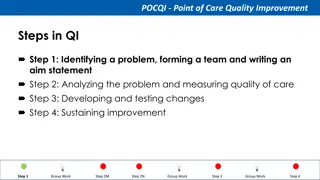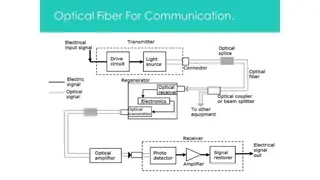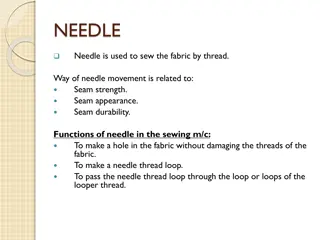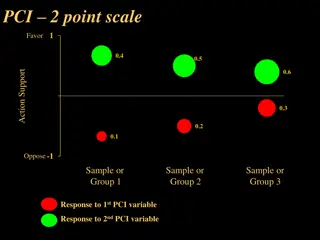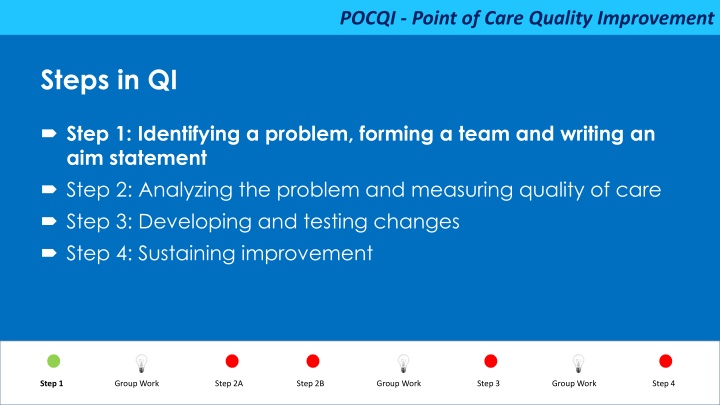
Improving Quality of Care at Point of Care: POCQI Steps for Healthcare Teams
This content outlines the Point of Care Quality Improvement (POCQI) process in healthcare, including steps such as problem identification, team formation, aim statement writing, data analysis, testing changes, and sustaining improvement. It emphasizes the importance of identifying problems, selecting the right team members, and working collaboratively to enhance patient outcomes efficiently.
Download Presentation

Please find below an Image/Link to download the presentation.
The content on the website is provided AS IS for your information and personal use only. It may not be sold, licensed, or shared on other websites without obtaining consent from the author. If you encounter any issues during the download, it is possible that the publisher has removed the file from their server.
You are allowed to download the files provided on this website for personal or commercial use, subject to the condition that they are used lawfully. All files are the property of their respective owners.
The content on the website is provided AS IS for your information and personal use only. It may not be sold, licensed, or shared on other websites without obtaining consent from the author.
E N D
Presentation Transcript
POCQI - Point of Care Quality Improvement Steps in QI Step 1: Identifying a problem, forming a team and writing an aim statement Step 2: Analyzing the problem and measuring quality of care Step 3: Developing and testing changes Step 4: Sustaining improvement v Step 1 Group Work Step 2A Step 2B Group Work Step 3 Group Work Step 4
POCQI - Point of Care Quality Improvement Step I : Learning objectives How to review data to identify problems How to prioritize which problems to work on How to form a team to work on that problem How to write a clear aim statement v Step 1 Group Work Step 2A Step 2B Group Work Step 3 Group Work Step 4
POCQI - Point of Care Quality Improvement Identifying a problem to solve Data-based decision: Review local health facility data and identify gaps related to quality of care Simple, easy to fix & amenable to change Value for patient outcomes Does not need many new resources Short turn-around time: early success is motivating Avoid long-term projects initially Decreasing maternal mortality in a small facility: Decreasing hemorrhagic disease in newborn (vitamin K related): since onset is late follow up after discharge is required to capture this v Step 1 Group Work Step 2A Step 2B Group Work Step 3 Group Work Step 4
POCQI - Point of Care Quality Improvement Select your team Look for volunteers who are: Enthusiastic - they want to make changes Involved - they are already doing the work that needs change Influential - others people listen to them and they can get things done v Step 1 Group Work Step 2A Step 2B Group Work Step 3 Group Work Step 4
POCQI - Point of Care Quality Improvement Select your team Identify who should be in the team: Need people from every level: from administrators to cleaners From all involved departments Assign some key roles Leader Recorder Communicator v Step 1 Group Work Step 2A Step 2B Group Work Step 3 Group Work Step 4
POCQI - Point of Care Quality Improvement Why is teamwork important for improvement ? Healthcare is delivered by a range of people in the hospital Given the opportunity, staff can identify problems and generate ideas to resolve them Participation improves ideas, increases buy-in, and reduces resistance to change Accomplishing things together increases the confidence of each member v Step 1 Group Work Step 2A Step 2B Group Work Step 3 Group Work Step 4
POCQI - Point of Care Quality Improvement Aim statement Characteristics of a good aim statement States a clear, specific aim what are we improving Linked to specific patient population who will be affected Should include a goal how much will we improve Neither too difficult nor too long to achieve Includes a timeline by when will the goal be achieved v Step 1 Group Work Step 2A Step 2B Group Work Step 3 Group Work Step 4
POCQI - Point of Care Quality Improvement SMART Aim Specific Measurable Achievable (but challenging) Relevant and recorded Timely v Step 1 Group Work Step 2A Step 2B Group Work Step 3 Group Work Step 4
POCQI - Point of Care Quality Improvement Aim statement Problem: All babies are not dried immediately after birth We will increase immediate drying at birth in all 100% of births from current 60% within 4 weeks, from May 1st to June 1st. Who (which patients)- Newborn What (the process)- Immediate drying How much (the amount of desired improvement)- from 60% to 100% By when (time over which the improvement will occur)- within 4 weeks v Step 1 Group Work Step 2A Step 2B Group Work Step 3 Group Work Step 4
POCQI - Point of Care Quality Improvement Aim statement Problem: Babies are cold at one hour following birth We will reduce the percentage of newborns with low temperature (<36.5 C ) from current 50% to <10% within 6 weeks, from 15th June to 30th July. Who (which patients) - Newborns What (the outcome) - Hypothermia (<36.5 C) How much (the amount of desired improvement) - from baseline of 50% to <10% By when (time over which improvement will occur)- within 6 weeks v Step 1 Group Work Step 2A Step 2B Group Work Step 3 Group Work Step 4
POCQI - Point of Care Quality Improvement Is this a good aim statement To establish skin to skin contact after delivery in low risk mothers admitted in Labour Room To establish skin to skin contact immediately after delivery for at least one hour from 0% to 25% within two weeks for newborns of low risk mothers admitted in Labour Room v Step 1 Group Work Step 2A Step 2B Group Work Step 3 Group Work Step 4
POCQI - Point of Care Quality Improvement v Step 1 Group Work Step 2A Step 2B Group Work Step 3 Group Work Step 4
POCQI - Point of Care Quality Improvement Steps in QI Step 1: Identifying a problem, forming a team and writing an aim statement Step 2: Analyzing the problem and measuring quality of care Step 3: Developing and testing changes Step 4: Sustaining improvement v Step 1 Group Work Step 2A Step 2B Group Work Step 3 Group Work Step 4
POCQI - Point of Care Quality Improvement Step 2 Learning objectives You will learn Tools for understanding processes and systems of healthcare How these tools can help identify possible causes for the problem How to develop indicators for process and outcome How to use indicators to track improvement v Step 1 Group Work Step 2A Step 2B Group Work Step 3 Group Work Step 4
POCQI - Point of Care Quality Improvement Step 2: Importance of Analysis Explore in detail possible causes of a problem Helps focus on things that are within our control Gives an opportunity for everyone to give their insights based on their role in the process Helps us understand what is happening in the system at present and thus identify possible solutions v Step 1 Group Work Step 2A Step 2B Group Work Step 3 Group Work Step 4
POCQI - Point of Care Quality Improvement Tools for analysis Why might a problem be happening? 1. Fishbone 2. Five Why s 3. Pareto Principle 4. Process Flowchart v Step 1 Group Work Step 2A Step 2B Group Work Step 3 Group Work Step 4
POCQI - Point of Care Quality Improvement 1. Fishbone : Identify all possible contributing factors Why might a problem be happening? People Places Procedures (practices) Policies anything else v Step 1 Group Work Step 2A Step 2B Group Work Step 3 Group Work Step 4
POCQI - Point of Care Quality Improvement 1. Fishbone : Identify all possible contributing factors People Policy Major influence Minor influence Problem Major influence Minor influence Place Procedure v Step 1 Group Work Step 2A Step 2B Group Work Step 3 Group Work Step 4
POCQI - Point of Care Quality Improvement 2. Five whys Understanding why something is the way it is Mothers are not breastfeeding Why? They feel uncomfortable taking their gown off Why? The gown opens at back, so they have to take entire gown off to breastfeed, so they feel uncomfortable. Why they have this type of a gown? That is what store keeper orders. Whydoesn t the store keeper order better gowns appropriate for breast feeding? Because no one has requested him to do that v Step 1 Group Work Step 2A Step 2B Group Work Step 3 Group Work Step 4
POCQI - Point of Care Quality Improvement 2. Five whys Understanding why something is the way it is Alternative Scenario Mothers are not breastfeeding Why? They feel uncomfortable taking their gown off Why ? There is no privacy to breast feed, so they feel exposed. Why is there no privacy to breastfeed? They are in a common ward. There are no curtains or separate covered space for privacy for breastfeeding v Step 1 Group Work Step 2A Step 2B Group Work Step 3 Group Work Step 4
POCQI - Point of Care Quality Improvement 3. Pareto Principle 80% of the problem is due to 20% of the couses v Step 1 Group Work Step 2A Step 2B Group Work Step 3 Group Work Step 4
POCQI - Point of Care Quality Improvement Pareto Principle Example: Medication error Monitoring not done Wrong Route Wrong Patient Expired Medicine Wrong Dosage Missed Dose v Wrong label on vial Dilution Error Improper Storage Prescription Error 0% 10% 20% 30% 40% 50% v Step 1 Group Work Step 2A Step 2B Group Work Step 3 Group Work Step 4
POCQI - Point of Care Quality Improvement Pareto Chart Example: Medication Error 96 98 99 100 100 93 90 86 80 80 65 60 80% of problems due to 30% of causes 45 v 40 20 0 Prescription Error Improper Storage Dilution Error Wrong Label Missed Dose Wrong Dose Expired Drug Wrong Patient Wrong Route Monitoring not done % Cum % v Step 1 Group Work Step 2A Step 2B Group Work Step 3 Group Work Step 4
POCQI - Point of Care Quality Improvement 4. Process flowchart How to develop a process flow chart 1.Decide the beginning and end points of the process 2.Identify the steps of the process as these are done at present 3.Link the steps with arrows showing direction 4.Now Review the chart to see whether the steps are in their logical order to achieve the end point efficiently: Is the order wrong, are some steps unnecessary? v Step 1 Group Work Step 2A Step 2B Group Work Step 3 Group Work Step 4
POCQI - Point of Care Quality Improvement How to create a process Flow chart One flow line out of step Two flow lines out of steps that lead to different options One flow line out of cloud steps that are not clear Step Ye s Option No Cloud step v Step 1 Group Work Step 2A Step 2B Group Work Step 3 Group Work Step 4
POCQI - Point of Care Quality Improvement Key tips Analysis helps identify several causes of the problem Focus on causes that are within our control and possible to remedy Try to find few barriers that account for most of the problem Use these tools to stimulate discussion among team members Involve all team members in the analysis Think about how re-organization can help with fixing the problem Video on Pareto chart v Step 1 Group Work Step 2A Step 2B Group Work Step 3 Group Work Step 4
POCQI - Point of Care Quality Improvement Step 2: Analyzing and measuring quality of care How to develop indicators for process and outcome How to use indicators to track improvement v Step 1 Group Work Step 2A Step 2B Group Work Step 3 Group Work Step 4
POCQI - Point of Care Quality Improvement Why measure? To know whether or not we have an improvement Helps us know how we are progressing in achieving our aim Data is objective helps communicate with others and among the team Helps us to compare how we are doing over time Data allows us to make comparisons with other units / facilities v Step 1 Group Work Step 2A Step 2B Group Work Step 3 Group Work Step 4
POCQI - Point of Care Quality Improvement Process and outcome indicators An indicator defines a rate/ratio or an event Measure of Process actions that are taken in delivery of care Washing hands to prevent infections Measure of Outcome ( the result of the actions taken ) Incidence of infection in the patients v Step 1 Group Work Step 2A Step 2B Group Work Step 3 Group Work Step 4
POCQI - Point of Care Quality Improvement Process and outcome indicators? If you don t measure outcome If you don t measure process How will you know whether you are making progress towards your aim or not? How will you know whether the action you want done is really happening or not How will you know whether the action is really leading to the desired outcome or not v Step 1 Group Work Step 2A Step 2B Group Work Step 3 Group Work Step 4
POCQI - Point of Care Quality Improvement Qualities of a good indicator Clear and unambiguous (teams will not confuse what is meant by a particular indicator) Should be linked to aims Should be used to test change and guide improvement Should be integrated into team s daily routine v Step 1 Group Work Step 2A Step 2B Group Work Step 3 Group Work Step 4
POCQI - Point of Care Quality Improvement Developing indicators Patients in hospital Patient gets treated Result DENOMINATOR PROCESS OUTCOME Number of women delivering in hospital Percentage of women receiving Inj. Oxytocin within 1 min of delivery Percentage of women with post-partum haemorrhage % women with post- partum hemorrhage v Step 1 Group Work Step 2A Step 2B Group Work Step 3 Group Work Step 4
POCQI - Point of Care Quality Improvement Example of good indicator Indicator: The rate of PPH in women in the hospital Numerator: Number of cases of PPH Denominator: Number of women giving birth Source: Labour room register in the health facility Person responsible: Delivery room nurse Frequency: Labour room register will be reviewed monthly v Step 1 Group Work Step 2A Step 2B Group Work Step 3 Group Work Step 4
POCQI - Point of Care Quality Improvement Developing indicators Babies born Babies receive care Result DENOMINATOR PROCESS OUTCOME Number of live babies born in facility Percentage of babies dried immediately % of babies getting skin to skin care at birth Percentage of babies hypothermic at 60 minutes after birth v Step 1 Group Work Step 2A Step 2B Group Work Step 3 Group Work Step 4
POCQI - Point of Care Quality Improvement Example of good indicator Indicator: Percentage of babies being dried immediately after birth Numerator: # of babies dried immediately after birth Denominator: # of normal vaginal live births Source: Labour Room Register Person responsible: Delivery room nurse Frequency: Review at the end of every shift v Step 1 Group Work Step 2A Step 2B Group Work Step 3 Group Work Step 4
POCQI - Point of Care Quality Improvement Plotting a time series chart Title: Clear and well defined title that includes what and when X and Y axis have clear scale and include indicator label X axis: Time period - days/weeks/months Y axis: measurement in %, proportion Annotation Numerator and denominator values are shown v Step 1 Group Work Step 2A Step 2B Group Work Step 3 Group Work Step 4
POCQI - Point of Care Quality Improvement Time-series chart: Percentage of women receiving uterotonic within one minute 100% % of women receiving oxytocin in 1 minute 80% 60% 40% 20% 0% Week 1 Week 2 Week 3 Week 4 Week 5 Week 6 Week 7 Week 8 Week 9 Week 10 Week 11 Week 12 Week 13 Week 14 Week 15 Week 16 v Step 1 Group Work Step 2A Step 2B Group Work Step 3 Group Work Step 4
POCQI - Point of Care Quality Improvement Key tips Looking at data overtime is crucial Frequent measurement (daily or weekly) is better than less frequent (monthly) Only collect data what you are going to use Don t overburden with endless data collection If possible, try to use data that are already recorded in your health facility or that will be easy to collect v Step 1 Group Work Step 2A Step 2B Group Work Step 3 Group Work Step 4
POCQI - Point of Care Quality Improvement v Step 1 Group Work Step 2A Step 2B Group Work Step 3 Group Work Step 4
POCQI - Point of Care Quality Improvement Steps in QI Step 1: Identifying a problem, forming a team and writing an aim statement Step 2: Analysing the problem and measuring quality of care Step 3: Developing and testing changes Step 4: Sustaining improvement v Step 1 Group Work Step 2A Step 2B Group Work Step 3 Group Work Step 4
POCQI - Point of Care Quality Improvement Step 3 Learning objectives How to come up with ideas about what to change to reach your aim How to plan a Plan-Do-Study-Act (PDSA) cycle to test these ideas What to do as you learn from a PDSA cycle Testing multiple change ideas for the same aim v Step 1 Group Work Step 2A Step 2B Group Work Step 3 Group Work Step 4
POCQI - Point of Care Quality Improvement Develop changes Determine possible change ideas that may lead to improvement Ask your team. Based on the analysis what changes can we make? Why will this change result in an improvement? How will it work? What will we expect to see as a result of this change? Organize changes according to importance and practicality Test one change at one time v Step 1 Group Work Step 2A Step 2B Group Work Step 3 Group Work Step 4
POCQI - Point of Care Quality Improvement Some categories of changes Category Meaning Improve knowledge or skills of workers Training or standards Eliminate waste Stop doing useless or harmful things Reassign tasks Change who does what Reorganize tasks Do tasks in different order or different location Improve patient relationship Listen to what patients want Reduce variation Do things to make work more standard v Step 1 Group Work Step 2A Step 2B Group Work Step 3 Group Work Step 4
POCQI - Point of Care Quality Improvement Some categories of changes Category Examples Improve knowledge or skills Teach about the importance of skin-to-skin care to keep babies warm Eliminate waste Have equipment closer to hand to reduce time getting it Reassign tasks Share work between staff members Reorganize tasks Start skin to skin and dry babies before cutting the cord Improve patient relationship Learn from mothers how they would like care to be provided during delivery Reduce variation Triage new admissions in the labour room v Step 1 Group Work Step 2A Step 2B Group Work Step 3 Group Work Step 4
POCQI - Point of Care Quality Improvement Testing Changes What is a PDSA cycle? PLAN Plan the change ACT DO Adopt, Adapt, Abandon Next steps on the basis of the test Test the change STUDY What did you learn? -Did the change lead to improvement ? -Is it significant improvement ? v Step 1 Group Work Step 2A Step 2B Group Work Step 3 Group Work Step 4
POCQI - Point of Care Quality Improvement Plan the test What will your team do ? Discuss and document the details for: What change idea will you test Who will make the change Where will this test be done When will the test be started For how long will this test be done How will we know whether this test happened as planned What do we expect to learn from this test? v Step 1 Group Work Step 2A Step 2B Group Work Step 3 Group Work Step 4
POCQI - Point of Care Quality Improvement Planning Example What change will you test? New protocol for post-partum assessment to pick up PPH earlier Who will make the change? Two of the nurses involved in developing the protocol Where will they do it? They will test the protocol in the post-partum ward When will they test? They will test it on their next shift How long will they test? They will test on one shift only What do you want to learn? Is it feasible to follow the protocol? Do we need to adapt the protocol? Do we need to change anything on the ward to make it easier to follow the protocol? v Step 1 Group Work Step 2A Step 2B Group Work Step 3 Group Work Step 4
POCQI - Point of Care Quality Improvement Do the test Sometimes the plan might not happen exactly as envisioned. Make sure you document exactly what happens as there is valuable learning happening while carrying out a test v Step 1 Group Work Step 2A Step 2B Group Work Step 3 Group Work Step 4
POCQI - Point of Care Quality Improvement Study the learning from the test After testing the change you need to think about: Was the test carried out as planned? If not why? What else needs to be done so this change can happen Is this change feasible in our setting Do we think it will solve the problem Does the change improve our indicator v Step 1 Group Work Step 2A Step 2B Group Work Step 3 Group Work Step 4
POCQI - Point of Care Quality Improvement Act Take action based on how the test happened After reviewing the results of the test the team will decide whether the change should be: Adopted The test worked very well and led to improvements in the data and is feasible and acceptable to do. Adapted The change idea worked partially but needs some modifications and further testing. This is usually the most common scenario. Abandoned The change idea did not work at all. v Step 1 Group Work Step 2A Step 2B Group Work Step 3 Group Work Step 4




